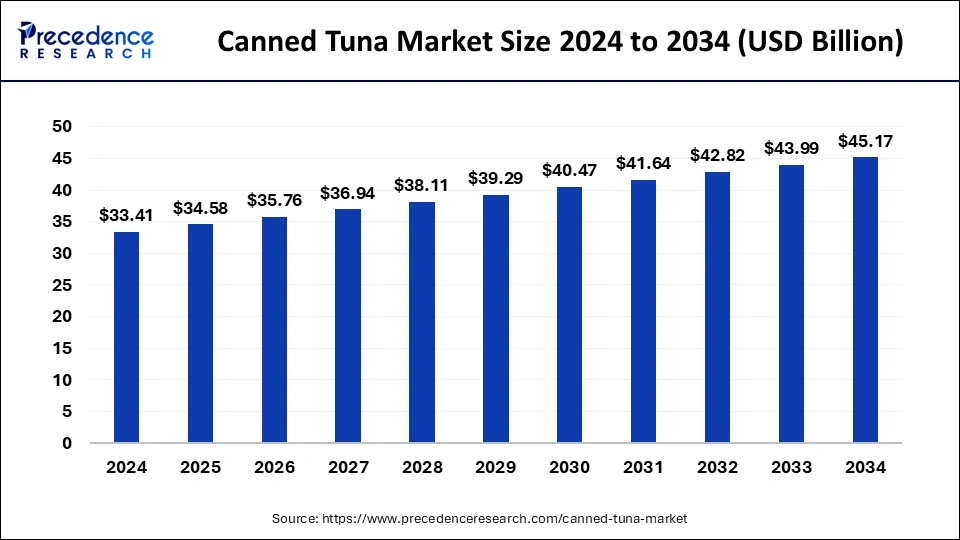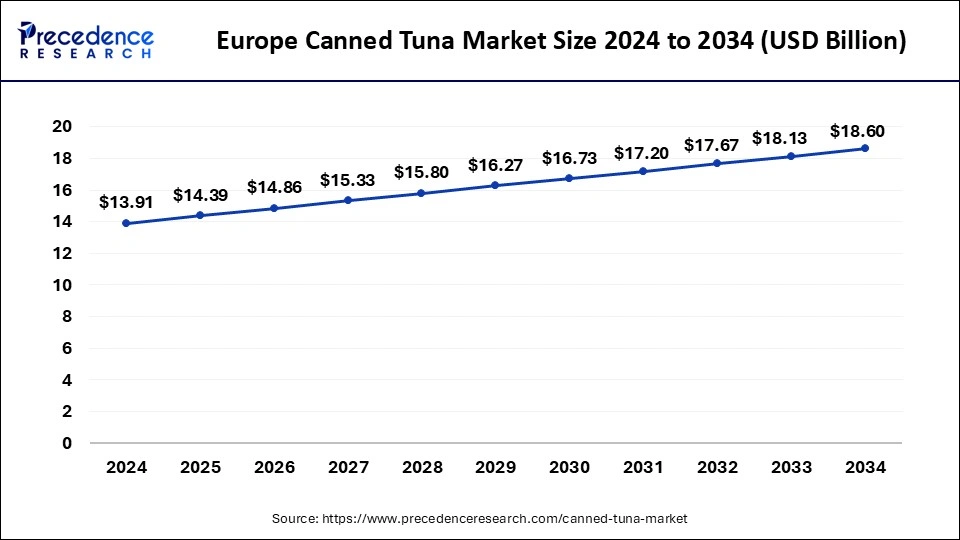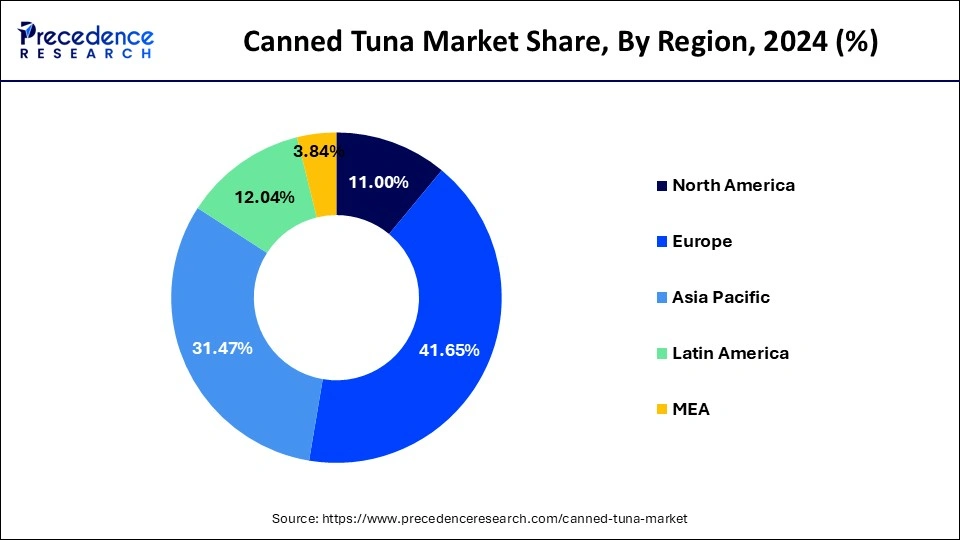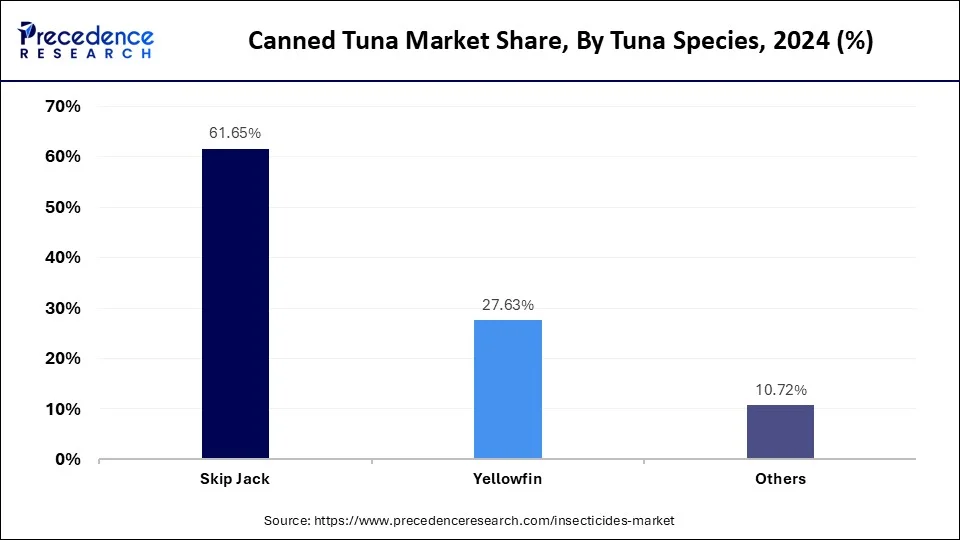List of Contents
Canned Tuna Market Size and Forecast 2025 to 2034
The global canned tuna market revenue was calculated at USD 33.41 billion in 2024 and is predicted to increase from USD 34.58 billion in 2025 to approximately USD 45.17 billion by 2034, expanding at a CAGR of 3.00% from 2025 to 2034.

Canned Tuna MarketKey Takeaways
- The global canned tuna market was valued at USD 33.41 billion in 2024.
- It is projected to reach USD 45.17 billion by 2034.
- The market is expected to grow at a CAGR of 3.00% from 2025 to 2034.
- By type, the ready-to-cook segment is anticipated to show considerable growth in the market over the forecast period.
- Europe led the global market with the highest market share of 41.65% in 2024.
- Middle East & Africa expected to grow at the fastest CAGR over the studied period.
- By Tuna Species, the skip jack segment captured the biggest revenue share of 61.65% in 2024.
AI integration in the Canned Tuna Market
Artificial intelligence is helping companies to improve efficiency in their supply chain, become more sustainable, and satisfy consumer needs. The use of AI-based tracking technologies allows monitoring fishing vessels and confirming that the tuna is harvested legally and sustainably, allowing brands to adhere to environmental regulations and increase transparency. AI can be used to draw faster and smarter decisions about pricing trends, consumer preferences, and global market dynamics.
Europe Canned Tuna Market Size and Growth 2025 to 2034
The Europe canned tuna market size was exhibited at USD 13.91 billion in 2024 and is projected to be worth around USD 18.60 billion by 2034, growing at a CAGR of 2.90% from 2025 to 2034.

Europe led the canned tune market in 2024. Canned tuna has long been a well-liked and practical fish option in Europe. Because of its high protein and omega-3 fatty acid content, health-conscious consumers frequently prefer tuna. Several factors, including customer tastes, the state of the economy, and sustainability concerns, affect the market. A growing consciousness of sustainability and ethical fishing methods has affected consumer choices.

The European canned tuna market has competition from major food corporations and seafood brands. Specific consumers have a preference for brands that emphasize environmental responsibility and sustainability. European consumers are becoming more interested in seafood supplied sustainably, especially tuna in cans. Several certification schemes, like the Marine Stewardship Council (MSC), have become more significant.
What Are the Key Trends Driving the North America Canned Tuna Market?
The North American canned tuna market accounted for a substantial share due to the presence of a strong retailing network in the region, with supermarket chains and the high growth of online grocery stores, is essential in promoting sales and availability. The habitat of the consumers in North America, especially the United States and Canada, is shifting toward sustainably sourced seafood, and the brands are transforming toward caring for fish stocks and environmentally friendly packaging. Further, the number of different people in North America has also led to the increasing popularity of international foods, whereby canned tuna is incorporated in many different kinds of foods in the world, such as sushi, curry, and Mediterranean salads.
The U.S. will see a tremendous growth in terms of the segment of canned tuna during the forecast period. The increasing consumer awareness of high-protein and low-fat foods has made the tuna a favorite food item among busy professionals and health-conscious consumers. Market acceleration is also being caused by the e-commerce and direct-to-consumer surge, as they provide a greater variety of products to consumers and give them home delivery choices and discounts. The well-developed retail channels, the change of diet norms, and the rise of online trading will push the North American canned tuna market.
- In May 2025, Chicken of the Sea introduced its Wild Caught Light Tuna Packet with Ghost pepper, a new bold taste that will satisfy spice lovers. The product is characterized by 15 grams of protein in a 2.5-ounce package. It can be used in a balanced form or directly by consumers in food.
Market Overview
The market for tuna in cans is enormous and has grown steadily over time. The nutritional advantages, lengthy shelf life, and ease of use of tuna in a can are some of the factors driving this expansion. Consumer preferences for ready-to-eat and convenient seafood items have driven the demand for canned tuna. Because canned tuna has a high protein level and omega-3 fatty acids. Health-conscious consumers frequently choose it. Various canned tuna varieties, such as skipjack, yellowfin light tuna, and albacore white tuna, are usually available in the market. Because light tuna contains less mercury, it is frequently selected.
Canned Tuna Market Growth Factors
- The need for quick-to-eat food products is rising as the world's population increases, particularly in metropolitan areas. Because canned tuna is an easily accessible and shelf-stable protein source, it is ideally positioned to meet this need. In many areas, individuals with more disposable income can choose more upscale and practical food options, such as tuna in a can. Many consumers favor canned tuna due to its accessibility and price.
- Changes in eating habits, such as emphasizing wholesome and environmentally friendly foods, may be a factor in the market expansion for canned tuna. Tuna is frequently regarded as a sustainable seafood choice compared to certain other fish kinds.
- Advancements in packaging technology, like easily opened lids, eco-friendly materials, and portion-controlled packaging, can increase canned tuna's market appeal and convenience.
- The globalization of food trade gives customers access to a wide range of goods from many geographical areas. This makes canned tuna varieties easier to get, satisfying a wide range of palates.
Market Scope
| Report Highlights | Details |
| Market Size in 2025 | USD 34.58 Billion |
| Market Size by 2034 | USD 45.17 Billion |
| Growth Rate from 2025 to 2034 | CAGR of 3.00% |
| Base Year | 2024 |
| Forecast Period | 2025 to 2034 |
| Segments Covered | Tuna Species, Type, Regions |
| Regions Covered | North America, Europe, Asia Pacific, Latin America, Middle East & Africa (MEA) |
Market Dynamics
Drivers
Rising Consumer Dependency on Ready-to-Cook and Ready-to-Eat Foods
There is a vast scope of consumers who need ready-to-cook/ready-to-eat food products, leading to the high growth of the processed food market. The main reason attributed to this trend is the high-paced lifestyle, which is mostly in the urban settings of the working segment of the population. The increasing population of working women and two-earner families has added more to the demand for food items that should be ready with minimum preparation, as convenience food items.
However, it is especially millennials who push this trend forward since they pay more attention to food products that can be prepared rather quickly, and are well-balanced in their nutritional intake. These convenient foods consist of canned foods, frozen foods, instant beverages, and instant mixes, which are capable of satisfying their tight schedules. The manufacturers are more willing to invest in innovative packaging, portion control, and product certifications in accordance with changing consumer trends and to assure quality.
Expanding E-Commerce Channels
The fast growth of e-commerce websites and in the supply chain of the food industry is also contributing highly to the increased growth of the market of processed food market. This convenience and the possibility to choose an individual delivery, as well as online-only deals, have led to a considerable increase in online shopping for food. The tech-savvy millennial generation is more willing to embrace the ease of transacting their daily food services in an e-commerce environment. The online platforms also give consumers information about products, reviews, and nutritional information, and further improve the aspect of informed decision-making and consumer trust. With the increase in the penetration of the internet and the usage of smartphones, the e-commerce channel is the main channel that is likely to be used to further widen the market for processed food products.
Restraint
Environmental Concerns Hinder Growth
One of the current constraints of the canned tuna industry is an increasing number of concerns about environmental and sustainability problems related to fishing. Consumer pressure has been growing overfishing and fishing practices that have led to degradation of marine ecosystems, especially the consideration of the environmental effects of non-sustainable fishing processes. It changes the consumer expectations that pressure companies to receive certifications given by reputable sustainability agencies and pursue traceable methods of responsible sourcing.
Opportunity
Growing Incorporation of High-Nutrition Foods
The growing attention to health and wellness has created a good market potential in the canned tuna product, as more people have become interested in using high-nutrition food in their everyday menu. Tuna is a lean protein, omega-3 fatty acids, vitamins, and mineral-rich food that is a favorite food among health-conscious consumers. To meet the time-saving requirements of modern life, such convenient and simple-in-preparation food as canned tuna offers a set of advantages as a component of a nutritionally balanced diet.
Increasing awareness of the need for diets rich in protein is also contributing to the demand. Besides the enhanced shelf life, the wide supply in the supermarket industry, and online facilities, as well as the diverse flavor and packaging capabilities, increase the attractiveness of tuna. With the increasing consumer preference for long-term wellness-promoting foods, the position of tuna as one of the functional, high-nutrition staples is likely to play an important role in market growth.
Tuna Species Insights
The skip jack segment holds the largest share of the canned tuna market. Katsuwonus pelamis, often known as skipjack tuna, is one of the species most frequently used to make tuna sauce. It is valued for its tasty and dark-colored meat and is noted for being comparatively tiny compared to other tuna species like albacore or yellowfin. Products from canned tuna frequently come in various cuts, like pieces or flakes.
One type of tuna commonly found in the market is a skipjack chunk. Because skipjack has a gentler flavor and a lighter color than other tuna species, it is frequently called "light tuna." The sustainability of tuna products could pique the curiosity of specific customers. There may be a niche for skipjack tuna sourced sustainably and with certifications from groups such as the Marine Stewardship Council (MSC). Different market sectors may target customers seeking particular flavor profiles, such as smoked or sauce-based skipjack tuna. Tuna can be processed in a variety of ways.

Yellowfin segment is expected to grow at the fastest rate during the forecast period. One of the main kinds of tuna frequently captured and prepared for the canned market is yellowfin tuna (Thunnus albacores). Because of its reputation for having delicate and tasty flesh, yellowfin is commonly used in canned tuna products. This highly migratory species can be found worldwide in tropical and subtropical waters. Different tuna species, such as skipjack, and yellowfin, are used in the canned tuna industry. Because of its flavor and texture, yellowfin tuna is frequently used for more expensive and superior canned tuna products. A substantial portion of the world's seafood market comprises canned tuna, which comes in various varieties, from plain to flavored and sauce-mixed.
Canned Tuna Market Revenue, By Tuna Species, 2022-2024 (USD Billion)
| Tuna Species | 2022 | 2023 | 2024 |
| Skipjack | 19.12 | 19.86 | 20.60 |
| Yellowfin | 8.61 | 8.93 | 9.25 |
| Others | 3.33 | 3.45 | 3.56 |
Type Insights
The ready-to-cook segment is expected to grow at a significant CAGR over the forecast period, fuelled by an increase in consumer demand for convenient and time-efficient meal solutions. This is the portion of products that have short preparation and cooking time, like marinated seafood, ready-seasoned meat, and half-done meal kits. In a busy modern lifestyle, particularly among working men and women. These products are also captured by health-conscious consumers since most of them provide transparent labelling, nutritional facts, and some are without preservatives or fake additives.
Moreover, with the development of the latest forms of retailing and online selling, there is an increased visibility of products and their accessibility, which has contributed to the evolution of the ready-to-cook segment both in the developed and emerging economies.
Source : (https://www.preparedfoods.com)
Recent Developments
- In April 2025, BlueNalu, a US-based seafood cultivation company, is planning to start with bluefin tuna in California and has already locked in deals to achieve its eventual goals to distribute the product worldwide.
- In December 2024, Subsidiary of Fisheries Development Oman, SIMAK, officially launched its first consumer canned tuna products in the domestic market. The focus of the new line is to make the accessed seafood more easily available and represent high-quality, sustainably caught fish.
- In August 2024, Wild Planet, the first and only company to ever offer sustainably caught canned seafood, announced a new Limited Edition Wild Tuna Snack Pack in collaboration with two of the most popular better-for-you product brands, Simple Mills and Chosen Foods.
Canned Tuna MarketCompanies
- Thai Union Group PCL
- Frinsa del Noroeste SA
- Jealsa Rianxeira SA
- Centuary Pacific Food, Inc.
- Golden Prize Canning Co. Ltd.
- Albacora S.A.
- American Tuna, Inc.
- Wild Planet Foods, Inc.
- Ocean Brands GP (The Jim Pattison Group)
- C.F. Fishery Co., Ltd (Bumble Bee Foods, LLC)
Segments Covered in the Report
By Tuna Species
- Skip Jack
- Yellowfin
- Others
By Type
- Ready-To-Eat
- Ready-To-Cook
By Geography
- North America
- U.S.
- Canada
- Europe
- U.K.
- Germany
- France
- Asia-Pacific
- China
- India
- Japan
- South Korea
- Rest of the World
For inquiries regarding discounts, bulk purchases, or customization requests, please contact us at sales@precedenceresearch.com
Frequently Asked Questions
Ask For Sample
No cookie-cutter, only authentic analysis – take the 1st step to become a Precedence Research client